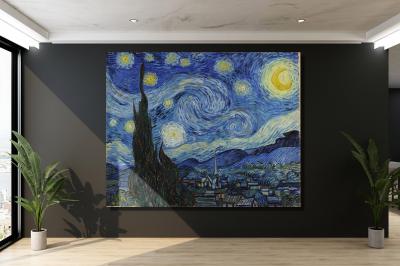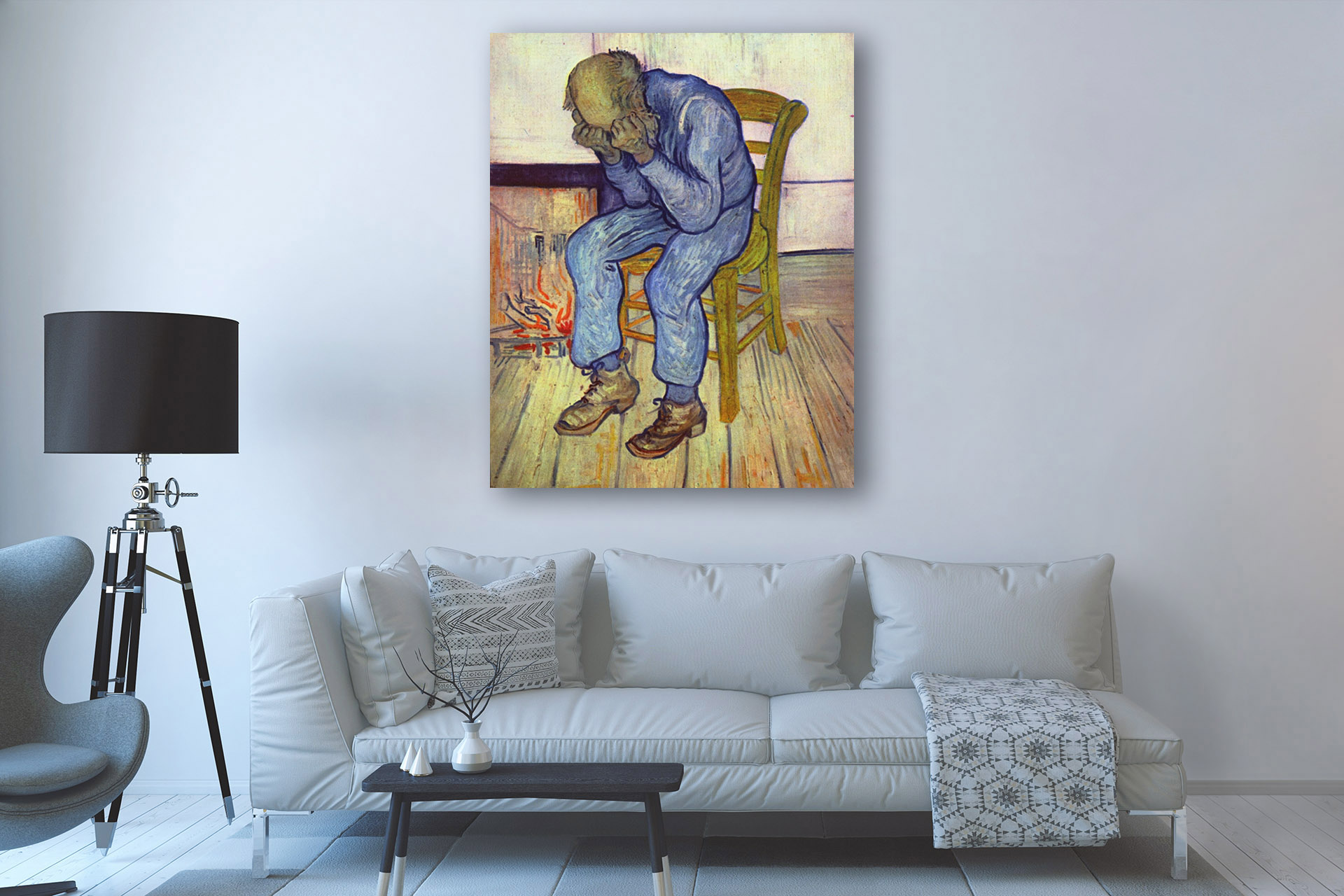At Eternities Gate
By Vincent van Gogh, 1890
At Eternity’s Gate: Vincent van Gogh’s Triumph of Turmoil
Vincent van Gogh, one of the most celebrated and enigmatic figures in the art world, left behind a legacy of emotionally charged and deeply personal works that continue to captivate audiences worldwide. Among his many masterpieces, “At Eternity’s Gate” holds a special place, offering a profound glimpse into the artist’s inner world, artistic genius, and enduring influence. In this extended exploration, we embark on a journey deep into the heart and soul of this iconic painting, delving into its creation, symbolism, the technical challenges faced by Van Gogh, its location, and the profound impact it has had on the art world.
The Creation of “At Eternity’s Gate”
In May 1890, Vincent van Gogh painted “At Eternity’s Gate” during his tumultuous period in Saint-Rémy-de-Provence, a serene town nestled in the picturesque landscapes of southern France. He resided in the Saint-Paul-de-Mausole asylum, a place of refuge and recovery where he sought solace from the relentless mental and emotional turmoil that had plagued him throughout his life.
This self-portrait, a confirmation to Van Gogh’s unwavering dedication to his craft and his relentless pursuit of artistic expression, is a window into his soul. The composition is profoundly intimate, as if the artist were extending an invitation for viewers to step into his inner world. His countenance is hauntingly gaunt, his eyes piercingly expressive, and his fiery red beard a stark contrast to the swirling, enigmatic background. The choice of colors and brushwork adds layers of depth and urgency, vividly conveying the artist’s inner turbulence.
“At Eternities Gate” Large Canvas Prints from WhiteClouds
Technical Challenges Faced by Van Gogh
The creation of “At Eternity’s Gate” was not without its technical challenges. Van Gogh’s unique style, characterized by bold, expressive brushwork and vivid colors, required meticulous execution. The use of impasto, a technique involving the thick application of paint, added texture and dimension to the canvas, intensifying the emotional impact of the piece. However, it also presented challenges in terms of drying time and handling, as thick layers of paint take longer to dry and can be prone to cracking.
Van Gogh’s impulsive and emotionally charged approach to painting further complicated matters. His brushwork was often rapid and spontaneous, reflecting the intensity of his emotions. This spontaneity posed challenges in achieving precise details and maintaining a sense of control over the medium.
Symbolism and Interpretation
“At Eternity’s Gate” is a visual manifestation of Van Gogh’s innermost struggles and his unyielding fascination with the profound questions of life, death, and the human condition. The title itself, “At Eternity’s Gate,” hints at a moment of existential reckoning, as if the artist were standing on the precipice of eternity, peering into the unfathomable abyss.
Location of the Painting
“At Eternity’s Gate” resides in the collection of the Kröller-Müller Museum in Otterlo, Netherlands. This tranquil location, nestled within the Hoge Veluwe National Park, provides a serene and fitting backdrop for the contemplation of Van Gogh’s masterpiece. The painting’s presence in this museum allows visitors to engage with it in an intimate and reflective setting, further enhancing the profound impact of the artwork.
Impact and Legacy
“At Eternity’s Gate” is more than a mere self-portrait; it is a profound window into Vincent van Gogh’s inner world and his relentless quest for truth and beauty through his art. While his life was marked by personal tribulations and suffering, his work has left an indelible mark on the art world and beyond.
This iconic painting has inspired countless artists, writers, filmmakers, and scholars who have sought to capture the essence of Van Gogh’s artistic vision and his profound connection to the human experience. The 2018 film “At Eternity’s Gate,” directed by Julian Schnabel and featuring Willem Dafoe as Vincent van Gogh, offers a cinematic exploration of the artist’s final years and the creation of this masterpiece.
The Life and Struggles of Vincent van Gogh
Vincent van Gogh’s life was marked by a series of personal and professional struggles that deeply influenced his art. Born in 1853 in the Netherlands, he struggled to find his calling before embarking on a career in art. His early works were characterized by dark, somber tones, reflecting his emotional turmoil and the challenges he faced in establishing himself as an artist.
Throughout his life, Van Gogh battled mental illness, including severe depression and psychosis, which led to his admission to various psychiatric institutions. Despite these challenges, his artistic output was prolific, with the last few years of his life being particularly productive.
Van Gogh’s deep connection to nature, intense emotional experiences, and love for vibrant colors are evident in his work, including “At Eternity’s Gate.” He believed that art had the power to convey profound truths and to connect with the human soul on a visceral level. Tragically, his struggles culminated in his premature death by suicide in 1890, just months after completing this iconic self-portrait.
 At Eternities Gate by Vincent van Gogh
At Eternities Gate by Vincent van Gogh
Conclusion
“At Eternity’s Gate” stands as a masterpiece that encapsulates the essence of Vincent van Gogh’s artistic brilliance and his unwavering commitment to self-expression. It confirms the transcendent power of art, capable of traversing the boundaries of personal suffering and resonating with the universal human experience. This painting continues to captivate and move viewers, inviting us to reflect on the complexities of our own lives and the eternal questions that bind us all. Vincent van Gogh may have stood at eternity’s gate, but his art ensures that he remains an eternal presence in the world of art and in the hearts of those who are touched by his work.
Frequently Asked Questions About “At Eternities Gate”
“At Eternity’s Gate” by Vincent van Gogh is a renowned and enigmatic work of art that often sparks curiosity and contemplation among viewers. Here are some frequently asked questions about this iconic painting:
What is the significance of the title “At Eternity’s Gate”? The title suggests a moment of profound existential reflection, as if the artist is contemplating the mysteries of life, death, and the afterlife. It invites viewers to explore the painting’s deeper meaning.
Why did Vincent van Gogh choose to paint a self-portrait in this manner? Van Gogh’s self-portraits were a recurring theme throughout his career. “At Eternity’s Gate” is particularly intimate and intense, reflecting his emotional state during the time it was created. Viewers often wonder why he chose to depict himself in such a raw and vulnerable manner.
Can you explain the technique of impasto used in this painting? Impasto is a technique in which the paint is applied thickly and with visible texture. Viewers often inquire about how impasto contributes to the emotional intensity of “At Eternity’s Gate” and the technical challenges it presents.
What is the location of the painting today? “At Eternity’s Gate” is housed in the Kröller-Müller Museum in Otterlo, Netherlands. Visitors frequently ask about the significance of its placement within the museum and the experience of viewing it in person.
How does this self-portrait compare to Van Gogh’s other self-portraits? Van Gogh created multiple self-portraits throughout his career, each with its own unique style and emotional resonance. People often inquire about the differences and similarities between “At Eternity’s Gate” and his other self-portraits. Jan Hulsker, a Dutch art historian, says “It is in these drawings and paintings that I see unmistakable signs of his mental collapse, otherwise rare in his work.”
What inspired Van Gogh to create this particular self-portrait? Viewers are often curious about the personal or artistic motivations that led Van Gogh to paint “At Eternity’s Gate.” Understanding the context and circumstances surrounding its creation can provide insight into its meaning. The following is a quote from Van Gogh “My intention with these two and with the first old man is one and the same, namely to express the special mood of Christmas and New Year. … Leaving aside whether or not one agrees with the form, it’s something one respects if it’s sincere, and for my part I can fully share in it and even feel a need for it, at least in the sense that, just as much as an old man of that kind, I have a feeling of belief in something on high even if I don’t know exactly who or what will be there.”
What impact did this painting have on the art world and subsequent artists? “At Eternity’s Gate” has had a profound influence on artists, filmmakers, and writers. Questions about its impact on the art world and its enduring legacy are common.
Can you provide more information about Vincent van Gogh’s life and struggles? Many viewers want to learn more about the artist’s life, including his battles with mental illness, his artistic journey, and the circumstances leading up to the creation of this painting. Today, there is no consensus on the contemporary diagnosis of Van Gogh’s medical condition. Proposed theories range from epilepsy to bipolar disorder, potentially worsened by his heavy consumption of absinthe, frequent smoking, and venereal disease. His symptoms were diverse, but at their worst, they included episodes of confusion and loss of consciousness, followed by times of stupor and incoherence, during which he was typically incapable of painting, drawing, or even writing letters.
These frequently asked questions reflect the enduring fascination with “At Eternity’s Gate” and its ability to provoke thought, emotion, and a deeper exploration of Vincent van Gogh’s artistic legacy.
Other Articles on Vincent van Gogh Paintings
At Eternities Gate by Vincent Van Gogh, 1890
Blossoming Almond Tree by Vincent Van Gogh, 1890
Cafe Terrace at Night by Vincent Van Gogh, 1888
Daubigneys Garden by Vincent Van Gogh, 1890
Green Wheat Field with Cypress by Vincent Van Gogh, 1889
Houses at Auvers by Vincent Van Gogh, 1890
Irises by Vincent Van Gogh, 1889
Night Café by Vincent Van Gogh, 1888
Portrait of Dr. Gachet by Vincent Van Gogh, 1890
Red Vineyards by Vincent Van Gogh, 1888
Road with Cypress and Star by Vincent Van Gogh, 1890
Starry Night by Vincent Van Gogh, 1889
Starry Night over the Rhone by Vincent Van Gogh, 1888
Sunflowers by Vincent Van Gogh, 1887
The Bedroom by Vincent Van Gogh, 1888
The Church at Aurers by Vincent Van Gogh, 1890
The Garden of the Asylum by Vincent Van Gogh, 1889
The Mulberry Tree by Vincent Van Gogh, 1889
The Potato Eaters by Vincent Van Gogh, 1885
The Yellow House by Vincent Van Gogh, 1888
Tree Roots by Vincent Van Gogh, 1890
Van Gogh Self Portrait by Vincent Van Gogh, 1887
Vase with Red Poppies by Vincent Van Gogh, 1886
View of Arles by Vincent Van Gogh, 1889
Wheat Field with Crows by Vincent Van Gogh, 1890
Wheat Field with Cypresses by Vincent Van Gogh, 1889
More WhiteClouds Videos
Contact us today to learn more about our 3D services and how we can help you achieve your goals.

